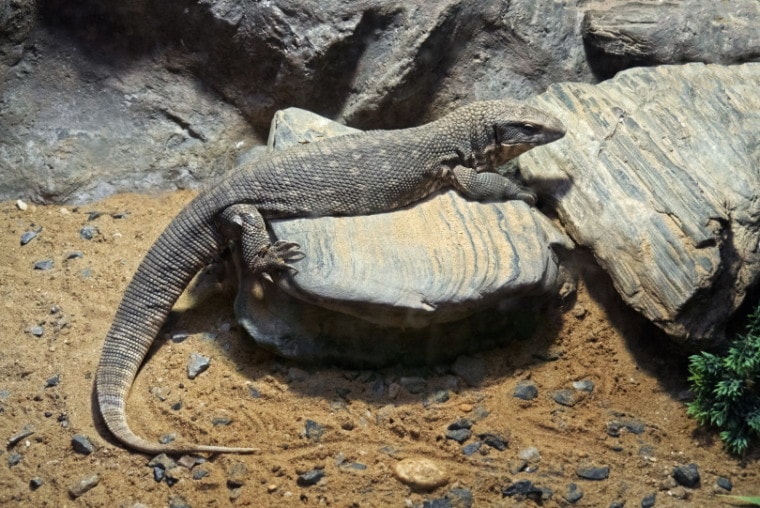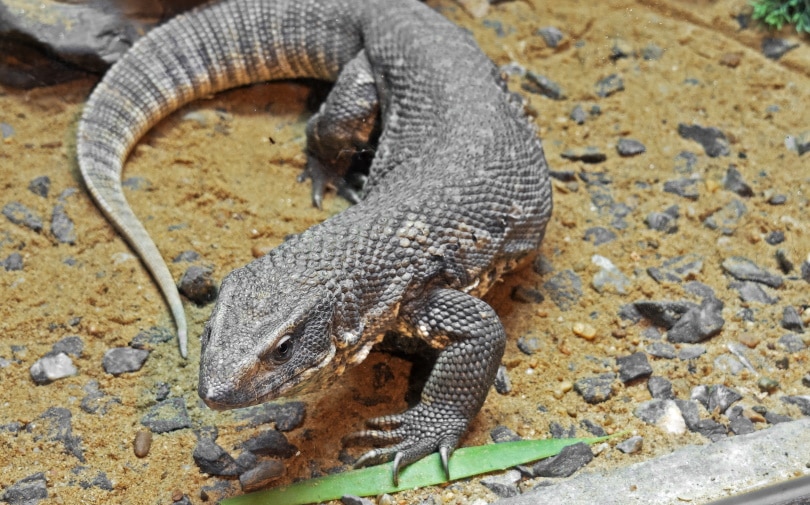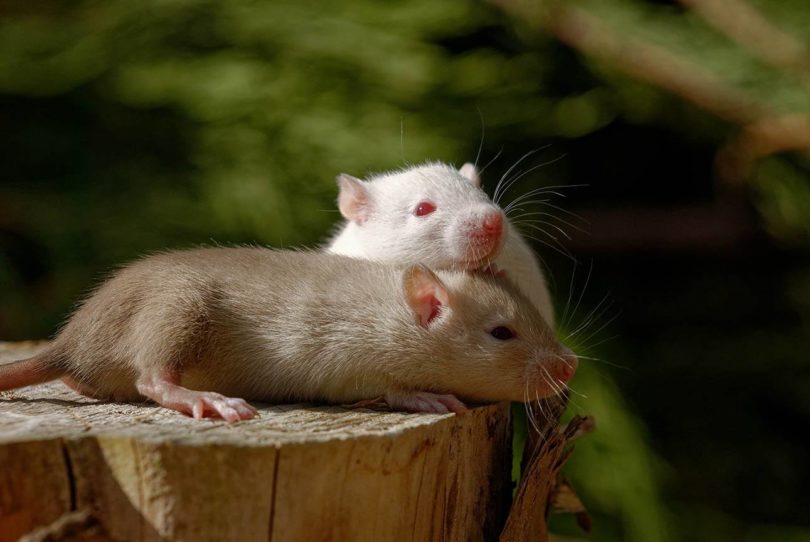
The Savannah monitor is a popular reptile pet. It is expected to live around 10 years, has relatively easy habitat and care requirements, and with regular contact, it can be open to regular handling and petting.
With that said, they can grow to 4 feet long as an adult, and although they may have simple habitat requirements, they will need a decent-sized tank that gives them plenty of room to move and turn around. If not handled regularly, the monitor’s sharp teeth and claws and their whip-like tail can be quite painful.
Read on to see if this lizard is right for you and what is required to properly care for one in your charge.
 Quick Facts about the Savannah Monitor
Quick Facts about the Savannah Monitor
| Species Name | Varanus exanthematicus |
| Family | Varanidae |
| Care Level | Easy |
| Temperature | 105°–110° F |
| Temperament | Tame with handling, aggressive without |
| Color Form | Tan or grey, with red, orange, or olive highlights |
| Lifespan | 10 years |
| Size | Roughly 4 feet long |
| Diet | Insects, rats, mice |
| Minimum Tank Size | 8’ x 4’ x 3’ |
| Tank Set-Up | UVB, Heater, hygrometer, substrate, branch, hide, water dish |
| Compatibility | Low |
Savannah Monitor Overview

The Savannah monitor is a monitor lizard. It is a medium species that is native to Africa and is also known as Bosc’s monitor, named after the French botanist to first describe it.
The monitor is a burrowing animal that will usually live on the ground but can sometimes be found in bushes and the lower branches of trees.
The species is a skilled escapologist, and you will need to take proper care to ensure that it does not escape from the tank you provide. This is more common in screen-sided tanks, but you might be surprised at the size of the hole that a 4-foot lizard can escape through.
Like most monitors, the Savannah monitor is well equipped for defense. It has sharp claws, sharp teeth, and can also strike with its tail in a whip-like fashion. As long as you regularly handle the lizard from a young age, it should be accepting of human handling, but a lack of handling may mean that the monitor is aggressive. Pay particular attention if you’re adopting an older and unwanted monitor because there is a chance that it will be aggressive.
The Savannah is considered a good starter lizard pet in some respects. It is smaller than most giant lizards and has relatively minimal care and habitat requirements. However, the need for regular handling and some of the specialist care needs mean that it is better suited to those that have kept other species of lizard.
How Much Do Savannah Monitors Cost?
Savannah monitors are popular pets, and there are plenty of people that breed them as pets. As such, they can be quite inexpensive, and you should be able to buy one for around $100. With the tank and full setup, required, expect to pay $500 or more initially.
Enquire at pet stores and rescues, because Savannahs start out just a few inches long but grow to be 4 feet long as adults. Some owners give them up when they become adults and are too large to handle. If you do adopt, ensure that the Savannah is friendly and has been handled.
Savannahs that were once wild should not be kept as pets. They tend to be more aggressive and will never be tame enough to keep in an enclosure.
Typical Behavior & Temperament

With regular handling from a young age, the Savannah monitor will tolerate handling and some petting, although it is unlikely to ever enjoy cuddles and hugs. If they are not handled properly, they can be quite aggressive when they reach maturity, and they have the tools to cause injury to their handlers.
Your monitor will investigate its surroundings primarily using its tongue. It darts its tongue out and back in again to “taste” the environment, and you may feel the flick of its tongue on your skin.
The lizard can become aggressive if it feels threatened, although it is also likely to burrow or hide in its burrow. They will also take refuge in their burrow if it is too hot, and these diurnal animals are active during the day and restful at night.
Appearance & Varieties
The Savannah monitor is classified as a medium monitor lizard and it is certainly smaller than giant lizard species. However, the sound of their adult size can catch some first-time owners by surprise when they see a juvenile that is only 5 inches long.
It has a short neck and tail, a wide head, and is colored brown or gray with pale spots. It also has a distinctive forked tongue. They have more muscular necks and limbs, which are useful for digging and burrowing and give them a distinct look compared to other, related lizard species.
This is considered one of the more docile species of monitor lizard and while they are considered small for this type of lizard, they grow substantially larger than other pet lizards like geckos and bearded dragons. Their size is one of the reasons that the Savannah may not be considered a good choice for amateur lizard owners. It is a species that is best left to those with experience of the smaller lizards first.
How to Take Care of Savannah Monitors

Savannah monitors are best described as intermediate lizards. They are easier to care for than other species of monitor, because they are the smallest, among the hardiest, and have easier care requirements than other monitors. However, they are considerably larger and take more care than small lizard species like bearded dragons and geckos. If you are considering one, you will need the following setup.
Habitat, Tank Conditions & Setup
A 50-gallon tank is large enough for a juvenile, but this will only last for the first 6 months of ownership. At which point, you will need to upgrade to a more substantial size and most owners choose the larger setup straight away. In this case, the smallest recommended size is 8’ x 4’ and is at least 3’ high. You can add a branch or two, but ensure that the Savannah will not be able to escape through the lid of the tank.
Your monitor will be capable of destroying most things. Avoid tanks with screen walls and do not provide unnecessary ornaments and other decorative items because they will just get broken and be of very little value.
Water Bowls
One of the most important additions to the tank is a large water bowl. The monitor will want to submerge its entire body. Some owners use a cat litter tray because this provides ample space and should be suitably waterproof.
Temperature

The tank should have an ambient temperature between 95° F and 100° F with a basking spot as hot as 130° F. The temperature should get cooler at night, with a cold area of 75° F in the evening, which means that you will need a thermostat. While lights can provide heat during the day, you will need ceramic heaters for the evening.
Lighting
A UVB light with a 10-hour cycle will provide the lighting your lizard requires.
Substrate
Monitors are burrowers, so they do appreciate being given adequate substrate in which to dig. They like to dig up to 2 feet deep but avoid substrate that can cause impaction because the Savannah is prone to eating substrate as well as insects at dinnertime.
Do Savannah Monitors Get Along with Other Pets?
Savannah monitors tend to live alone because of the amount of space they require in their tank. However, if you have room and you can provide a substantially large setup, a male and a female can live together happily.
The monitor can be quite nervous and a little skittish. This can lead to them attacking other animals including cats and dogs, and they are certainly large enough to cause injury or harm to such animals. They are especially likely to attack other animals if they make noise or do anything else to startle the lizard.
What to Feed Your Savannah Monitor

The opportunistic carnivore will eat mice, rats, and lizards. Because they are opportunistic, this means that they are prone to putting on weight, so you should monitor the amount you feed your lizard carefully.
Juveniles will eat approximately one to four fuzzies or one small mouse, along with a handful of insects.
Adults will eat two or three adult mice a week. Again, this should be supplemented with insects.
Insects should be gut-loaded and can include crickets as well as cockroaches and earthworms.
Keeping Your Savannah Monitor Healthy
You should try to find a specialist exotics vet that has experience treating lizards. They will be able to spot symptoms of common illnesses including parasites. Parasites are common in captive-bred monitors, and they can live in the monitor or on it, leaching blood through their skin.
Other common illnesses include respiratory infections and metabolic bone disease.
Ensure a good diet, keep the tank at the right temperature and humidity, and provide good calcium and vitamin D supplementation to help prevent these common illnesses and to ensure the continued good health of your monitor.
Breeding
You will need more than a simple habitable setup if you want to breed Savannahs. They will require more space and will especially benefit from having more substrate into which they can burrow.
Breeding pairs should be at least 18 months and females will require higher levels of calcium and vitamin D to ensure good egg development. Males and females should be separated once mating occurs, which means that you will need two separate and good-quality habitats.
Eggs need to be removed and incubated, and you will need to provide neonatal care once the lizards hatch. Even though a monitor can have a clutch of up to 40 eggs, the relatively low retail value combined with the high cost of keeping breeding pairs makes breeding prohibitive for most monitor parents.
 Are Savannah Monitors Suitable for You?
Are Savannah Monitors Suitable for You?
Savannah monitors are described as being the best monitor for novice owners, but they are still best left to pet parents that have kept smaller lizards before. They may not grow as big as water monitors, for example, but can still reach a length of 4 feet when fully mature. Similarly, they may not take as much care as some other species of monitor, but they need reliable and accurate heating, lighting, and humidity, and can become ill if they do not enjoy the right habitat conditions in their tank.
Monitors are fascinating and will tolerate handling, as long as they are handled from a young age, but if you have never kept lizards before, you may be better opting for something like a bearded dragon, to ease you into keeping this unique type of pet.
Featured Image Credit: Cherdchai Chaivimol, Shutterstock
 Quick Facts about the Savannah Monitor
Quick Facts about the Savannah Monitor






